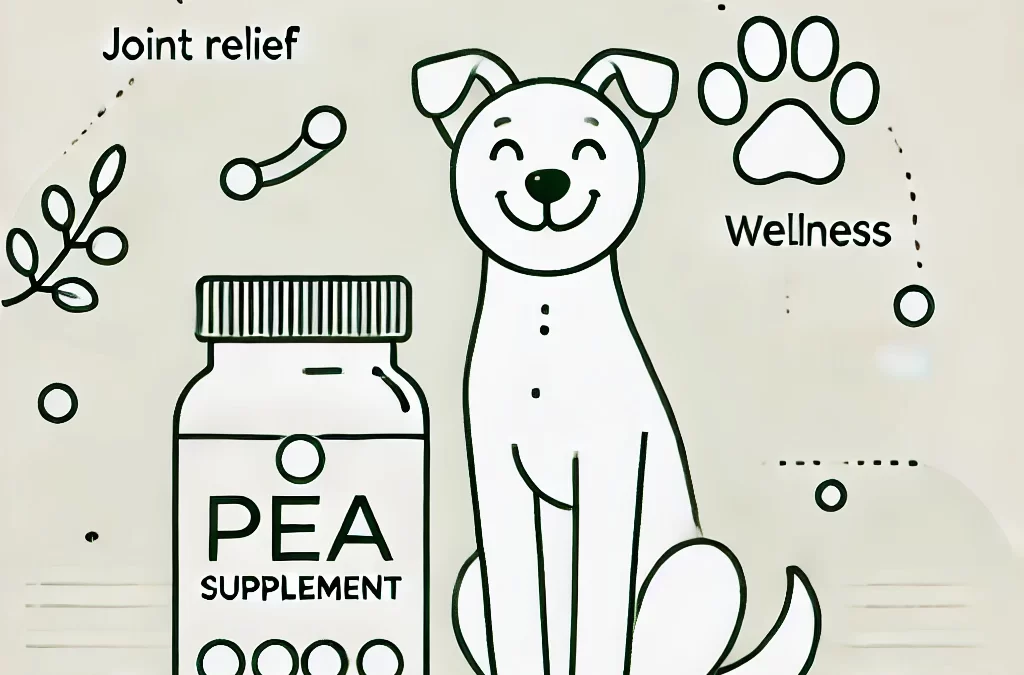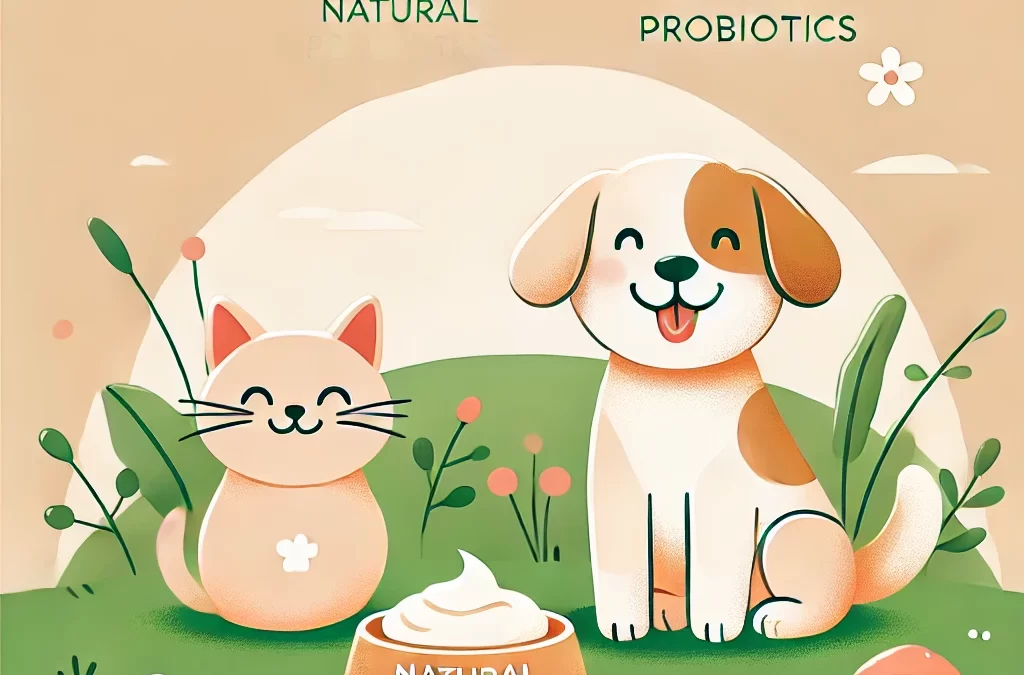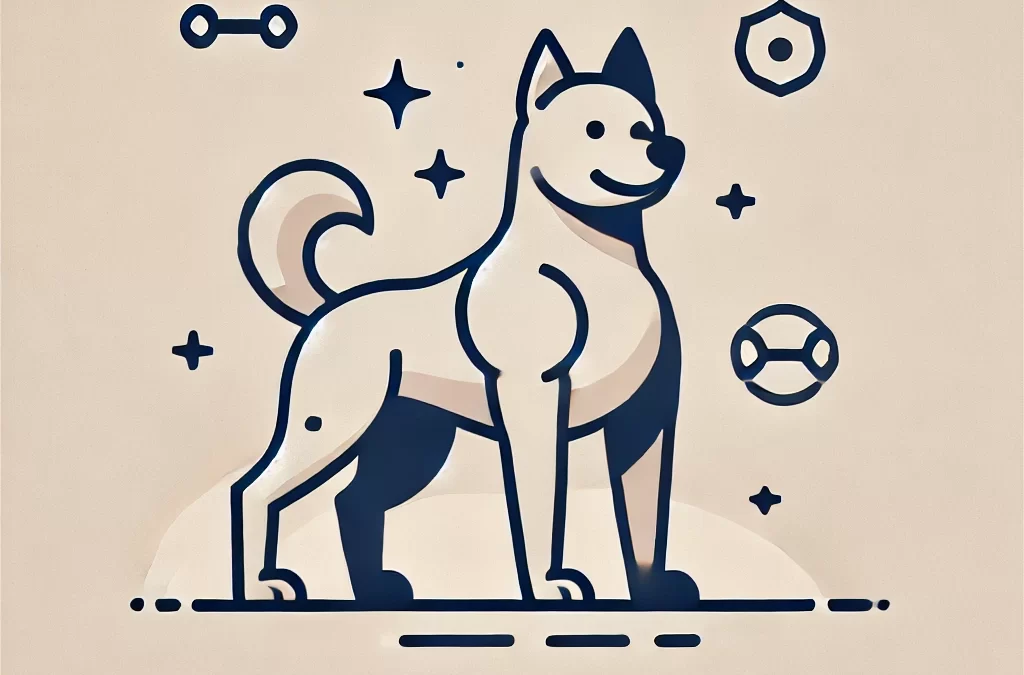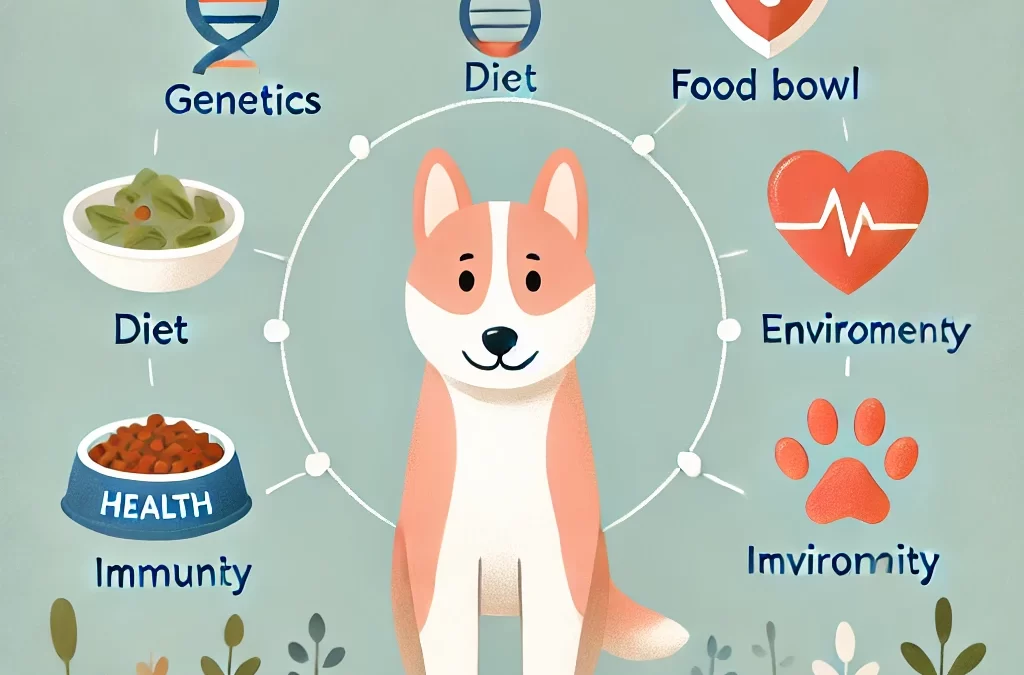
utworzone przez TCMVET | 13 listopada 2024 | Żywność i zdrowie
Palmitoylethanolamide, czyli PEA, zyskuje popularność w świecie opieki nad psami ze względu na swoje naturalne właściwości przeciwbólowe i przeciwzapalne. Pierwotnie odkryty jako wytwarzany przez organizm amid kwasu tłuszczowego, PEA jest związkiem podobnym do endokannabinoidów, występującym w różnych tkankach, w tym w mózgu i układzie odpornościowym. Ten wyjątkowy związek, obecny w produktach spożywczych, takich jak jaja i soja, wykazał potencjalne korzyści w zakresie wspomagania leczenia bólu i zmniejszania stanu zapalnego zarówno u ludzi, jak i zwierząt. Ale co to oznacza dla naszych psich towarzyszy?
Czym jest PEA i dlaczego jest przydatna dla psów?
PEA jest naturalnie wytwarzana w organizmach ludzi i psów jako odpowiedź na stan zapalny i ból. Jako związek endogenny, PEA współpracuje z układem endokannabinoidowym, pomagając modulować stan zapalny i percepcję bólu bez efektów psychoaktywnych. Dzięki temu jest bezpieczniejszą alternatywą dla zwierząt domowych w porównaniu z tradycyjnymi lekami, szczególnie w przypadku długotrwałego stosowania.
Główne korzyści stosowania PEA u psów:
- Przeciwbólowy: PEA oddziałuje na receptory w układzie nerwowym, stanowiąc naturalny sposób łagodzenia dyskomfortu.
- Właściwości przeciwzapalne: Działa na odpowiedź immunologiczną organizmu, zmniejszając stan zapalny, co może przynieść korzyści psom cierpiącym na zapalenie stawów, zapalenie skóry i inne schorzenia zapalne.
- Improved Quality of Life: Łagodząc ból i stan zapalny, PEA może poprawić sprawność ruchową, poziom energii i ogólne samopoczucie.
Jak działa PEA?
W przeciwieństwie do innych leków przeciwbólowych, PEA nie blokuje sygnałów bólowych bezpośrednio. Zamiast tego działa na tak zwany „efekt otoczenia”, wzmacniając naturalne procesy regulujące ból i stan zapalny. Oto uproszczony opis jego działania:
- Interakcja z receptorami kannabinoidowymi:PEA pośrednio oddziałuje na receptory kanabinoidowe (receptory CB2) w układzie odpornościowym, co sprzyja zrównoważonej odpowiedzi immunologicznej.
- Hamowanie enzymów zapalnych:Hamuje enzymy wywołujące stany zapalne, dzięki czemu naturalne procesy lecznicze organizmu działają skuteczniej.
- Stabilizacja komórek tucznych:PEA stabilizuje komórki tuczne, czyli komórki układu odpornościowego, które uwalniają histaminę w odpowiedzi na uraz lub stan zapalny, zmniejszając dyskomfort związany ze stanem zapalnym.
W leczeniu jakich schorzeń u psów pomaga PEA?
PEA może być korzystna dla psów cierpiących na wiele przewlekłych schorzeń:
- Artretyzm:Jego działanie przeciwzapalne może pomóc psom cierpiącym na zapalenie stawów i sztywność.
- Skin Conditions:U psów z przewlekłym zapaleniem skóry może nastąpić ulga w swędzeniu i podrażnieniu.
- Choroby neurologiczne:Niektóre badania sugerują, że PEA może pomóc psom cierpiącym na ból nerwowy, uspokajając nadmiernie aktywne komórki nerwowe.
- Rekonwalescencja pooperacyjnaWłaściwości przeciwbólowe PEA mogą wspomagać szybszy powrót do zdrowia i łagodzenie bólu po operacji.
Bezpieczne stosowanie PEA: dawkowanie i środki ostrożności
PEA jest na ogół dobrze tolerowana, jednak ważne jest, aby stosować ją w bezpieczny sposób:
- Skonsultuj się z weterynarzem:Zawsze skonsultuj się z lekarzem weterynarii zanim wprowadzisz PEA do codziennej diety swojego psa, zwłaszcza jeśli przyjmuje on inne leki.
- Zacznij powoli: Wprowadź PEA w mniejszych dawkach i monitoruj wszelkie reakcje. PEA jest zazwyczaj dostępna w postaci tabletek, proszku lub do żucia, a zalecenia dotyczące dawkowania zależą od masy ciała.
- Obserwuj i dostosuj: Monitoruj reakcję swojego psa i w razie potrzeby dostosowuj dawkowanie pod nadzorem lekarza weterynarii.
Wybór odpowiedniego suplementu PEA dla Twojego psa
Nie wszystkie suplementy PEA są takie same. Wybierając produkt PEA, zwróć uwagę na:
- Czystość i jakość: Wybieraj suplementy przebadane pod kątem czystości i wolne od zanieczyszczeń.
- Forma mikronizowana:Ta forma PEA jest bardziej biodostępna, co oznacza, że jest ona skuteczniej wchłaniana do organizmu psa.
- Produkty przeznaczone specjalnie dla psów:Niektóre marki projektują PEA specjalnie dla zwierząt domowych, zapewniając tym samym właściwą dawkę i skład.
Ostatnie przemyślenia: przyszłość PEA w opiece nad zwierzętami
Ponieważ coraz więcej właścicieli zwierząt domowych poszukuje naturalnych opcji, aby poprawić życie swoich psów, PEA wyróżnia się jako obiecujący dodatek. Jego wieloaspektowe podejście do łagodzenia bólu i zarządzania stanem zapalnym może przynieść korzyści starzejącym się zwierzętom, tym z przewlekłymi schorzeniami i każdemu psu potrzebującemu bezpiecznego, delikatnego wsparcia dla dobrego samopoczucia.
Dzięki coraz większym badaniom i większej liczbie formulacji przeznaczonych dla zwierząt domowych PEA może wkrótce stać się podstawą holistycznej opieki nad zwierzętami. Jej unikalne mechanizmy i udowodnione bezpieczeństwo sprawiają, że jest to realna, innowacyjna opcja wspierająca komfort i witalność psów bez skutków ubocznych konwencjonalnych leków.

utworzone przez TCMVET | 13 listopada 2024 | Żywność i zdrowie
Podobnie jak ludzie, zwierzęta domowe mogą odnieść duże korzyści z probiotyków, „dobrych bakterii”, które wspierają zdrowie jelit, odporność i ogólne samopoczucie. Podczas gdy komercyjne probiotyki są popularne, naturalne źródła probiotyków wyłaniają się jako skuteczne i holistyczne podejście. W tym artykule zagłębiamy się w to, czym są naturalne probiotyki, gdzie można je znaleźć i jak mogą naturalnie poprawić zdrowie Twojego zwierzaka.
1. Czym są naturalne probiotyki dla zwierząt domowych?
- Definicja:Naturalne probiotyki to żywe, pożyteczne bakterie występujące w naturalnie fermentowanej żywności, ziołach i roślinach.
- Jak działają:Te mikroorganizmy pomagają zrównoważyć mikrobiom jelitowy, poprawić trawienie, wzmocnić odpowiedź immunologiczną, a nawet mogą pozytywnie wpływać na nastrój.
- Różnica w stosunku do komercyjnych probiotyków:Naturalne probiotyki pochodzą z pełnowartościowych produktów spożywczych i są mniej przetworzone, oferując rozwiązanie bliższe naturze.
2. Korzyści płynące ze stosowania naturalnych probiotyków dla zwierząt domowych:
- Lepsze trawienieProbiotyki wspomagają trawienie, wchłanianie składników odżywczych i łagodzą problemy trawienne, takie jak gazy czy biegunka.
- Silniejsza odporność:Zrównoważona mikroflora jelitowa wzmacnia układ odpornościowy, pomagając zwierzętom skuteczniej zwalczać infekcje.
- Ulgę w alergiiRegularne przyjmowanie probiotyków może łagodzić objawy alergii skórnych poprzez redukcję stanów zapalnych w jelitach, gdzie powstaje wiele reakcji immunologicznych.
- Nastrój i zachowanieBadania wykazują związek między zdrowiem jelit i nastrojem, co sugeruje, że probiotyki mogą mieć uspokajający wpływ na zwierzęta domowe.
3. Źródła naturalnych probiotyków dla zwierząt domowych:
- Jogurt i kefir:Zwykły, niesłodzony jogurt i kefir są bogate w probiotyki, takie jak Lactobacillus acidophilus I BifidobakterieMogą one wspomagać zdrowie układu trawiennego, jeśli są podawane w małych, bezpiecznych ilościach.
- Fermentowane warzywa:Niewielkie ilości sfermentowanych warzyw, np. kiszonej kapusty (niesolonej), mogą być źródłem probiotyków, ale należy je wprowadzać ostrożnie.
- Ocet jabłkowy:Surowy ocet jabłkowy zawiera enzymy i korzystne bakterie, ale przed użyciem należy go rozcieńczyć, aby zapobiec rozstrojowi układu trawiennego.
- Zioła i organizmy glebowe: Niektóre zioła, takie jak korzeń mniszka lekarskiego i korzeń cykorii, zawierają prebiotyki, które odżywiają korzystne bakterie. Ponadto probiotyki na bazie gleby znajdujące się w ekologicznej glebie bezpiecznej dla zwierząt domowych mogą naturalnie wspierać zdrowie jelit.
4. Jak wprowadzić naturalne probiotyki do diety swojego pupila
- Zacznij od małego:Wprowadzaj niewielkie ilości i obserwuj, czy nie występują jakieś zaburzenia lub reakcje trawienne.
- Obserwuj i dostosuj:Jeśli zauważysz poprawę u swojego pupila, stopniowo zwiększaj częstotliwość lub ilość podawanego pokarmu zgodnie z zaleceniami lekarza weterynarii.
- Kluczem jest konsekwencja:Regularne, stałe dawki naturalnych probiotyków przynoszą najlepsze efekty, dlatego znajdź metodę, która sprawdzi się w codziennej rutynie Twojego pupila.
5. Kiedy rozważyć naturalne probiotyki zamiast suplementów
- Dla wrażliwych zwierząt:Zwierzęta, które źle tolerują komercyjne suplementy probiotyczne, mogą lepiej reagować na ich naturalne źródła.
- Leczenie poantybiotykowe:Po kuracji antybiotykowej naturalne probiotyki mogą pomóc przywrócić mikrobiom jelitowy.
- Codzienne utrzymanie zdrowia:Jeśli szukasz podejścia zapobiegawczego, naturalne probiotyki mogą być delikatnym i skutecznym sposobem na codzienne dbanie o zdrowie.
6. Wskazówki dotyczące bezpieczeństwa i rzeczy, na które należy zwrócić uwagę
- Unikaj dodatków: Wybieraj naturalne, niesmakowe i niesłodzone źródła probiotyków, ponieważ dodatki takie jak cukier i sztuczne aromaty mogą szkodzić zwierzętom.
- Consult Your VetZawsze skonsultuj się z lekarzem weterynarii, zwłaszcza jeśli Twój pupil ma jakieś schorzenia lub alergie.
- Monitoruj skutki uboczne:W rzadkich przypadkach u zwierząt domowych może wystąpić łagodna biegunka lub wzdęcia, gdy ich organizm przystosowuje się do nowych probiotyków.
Wnioski:
Naturalne probiotyki oferują holistyczny sposób na poprawę zdrowia Twojego pupila, wspomagając trawienie, odporność, a nawet nastrój. Wprowadzając bezpieczne, naturalne źródła probiotyków, zapewniasz bardziej naturalną ścieżkę do dobrego samopoczucia. Dzięki cierpliwości i konsekwencji te naturalne środki wspomagające mogą stać się niezbędną częścią rutyny Twojego pupila, zapewniając mu szczęśliwsze i zdrowsze życie.

utworzone przez TCMVET | 13 listopada 2024 | Rak i guzy u psów
Tłuszczowe grudki, czyli lipoma, są jednymi z najczęstszych nienowotworowych narośli u psów, szczególnie w miarę starzenia się. Właściciele zwierząt domowych często odczuwają niepokój, gdy odkrywają te grudki, ale większość lipoma jest łagodna. W tym artykule przyjrzymy się, jak odczuwa się te grudki, jak odróżnić je od innych narośli i podpowiemy, kiedy należy skonsultować się z lekarzem weterynarii.
1. Czym są grudki tłuszczu?
- Definicja lipomów:Lizaki to miękkie, tłuszczowe złogi, które tworzą się pod skórą, zwykle u starszych lub otyłych psów.
- Popularne lokalizacje:Występują zazwyczaj na tułowiu, pachach i kończynach, ale mogą pojawiać się w różnych miejscach.
- Przyczyna:Choć dokładne przyczyny nie są do końca znane, mogą być związane z wiekiem, rasą, genetyką i wagą.
2. Wrażenie grudek tłuszczu:
- Miękki i ruchomy: Lipomas są zazwyczaj miękkie i lekko gąbczaste, przypominają nieco bryłę ciasta pod skórą. Łatwo je przesunąć delikatnym pchnięciem, co często odróżnia je od twardszych, mniej ruchomych narośli.
- Bezbolesny:W przeciwieństwie do torbieli i ropni, tłuszczaki nie powodują bólu, chyba że uciskają nerw lub staw.
- Jednolita tekstura:Lipaki zazwyczaj mają taką samą konsystencję w całym organizmie – jednorodną i ciastowatą.
3. Różnice między tłuszczakami a innymi rodzajami guzów:
- Cysts:Często są one twardsze, mogą być wypełnione płynem i czasami mieć centralny punkt, w przeciwieństwie do tłuszczaka, który ma jednorodną budowę.
- Ropnie:Zwykle są bolesne i ciepłe w dotyku, często towarzyszy im zaczerwienienie.
- Wzrosty nowotworowe: Złośliwe guzy mogą wydawać się twardsze, często są nieruchome i mogą rosnąć szybko lub nieregularnie. Guzy mogą wydawać się nieregularne w kształcie lub twarde.
- Włókniaki:Te łagodne guzy są twardsze od tłuszczaków i mniej ruchome, ale zazwyczaj są nieszkodliwe.
4. Kiedy należy się martwić?
- Tempo wzrostu:Jeśli guzek rośnie szybko, zmienia kształt lub staje się bolesny, najlepiej natychmiast zgłosić się do weterynarza.
- Obawy dotyczące lokalizacji:Guziki w pobliżu stawów lub w miejscach ograniczających ruchomość mogą wymagać usunięcia lub monitorowania.
- Wiele grudek:U niektórych ras często występuje wiele tłuszczaków, ale jeśli nowe guzki pojawiają się szybko, należy rozważyć kontrolę weterynaryjną.
5. Diagnostyka tłuszczaków:
- Badanie weterynaryjne:Weterynarz może potwierdzić palpacją, czy guzek jest tłuszczakiem.
- aspiracja cienkoigłowa (FNA):Aby uzyskać dokładniejszą diagnozę, FNA umożliwia pobranie komórek z guza do analizy. Pozwala to ustalić, czy guz jest łagodny, czy też wymaga dalszych badań.
6. Czy tłuszczaki należy usuwać?
- Kiedy potrzebna jest operacja:Zazwyczaj tłuszczaki nie są leczone, chyba że powodują dyskomfort, ograniczają ruchomość lub nadmiernie rosną.
- Opcje małoinwazyjne:Nowsze metody, takie jak liposukcja lub zastrzyki ze sterydami, mogą w niektórych przypadkach pomóc w zmniejszeniu tłuszczaków.
7. Zapobieganie i porady zdrowotne w celu zmniejszenia ilości tłuszczaków:
- Utrzymuj zdrową wagę:Otyłość jest znanym czynnikiem ryzyka powstawania tłuszczaków.
- Regularne wizyty kontrolne:Regularne wizyty u weterynarza pozwalają na wczesne wykrycie i monitorowanie wszelkich nowych narośli.
- Zrównoważona dieta i ćwiczeniaZrównoważona dieta i regularne ćwiczenia mogą pomóc w zapobieganiu otyłości, co może zmniejszyć prawdopodobieństwo wystąpienia tłuszczaków.
Wnioski: Chociaż grudki tłuszczu u psów mogą być niepokojące, często są nieszkodliwe i łatwe w leczeniu. Dzięki zrozumieniu odczucia, przyczyn i objawów lipomów właściciele psów mogą podejmować świadome decyzje dotyczące zdrowia swojego pupila. Jeśli nie jesteś pewien co do grudki u swojego psa, zawsze zasięgnij porady specjalisty, aby mieć spokój ducha.

utworzone przez TCMVET | 12 listopada 2024 | Rak i guzy u psów
Dla właścicieli zwierząt domowych, którzy chcą pomóc swoim psom rozwinąć szczupłą masę mięśniową, zwiększyć siłę lub dojść do siebie po urazie, pomysł suplementów budujących mięśnie może wydawać się intrygujący. Chociaż nie jest to standard dla każdego psa, te suplementy mogą być korzystne dla niektórych ras, psów o dużej energii, psów pracujących, a nawet tych w trakcie rekonwalescencji. Tutaj przyjrzymy się korzyściom suplementów budujących mięśnie dla psów, kluczowym składnikom, których należy szukać, oraz wskazówkom dotyczącym wyboru bezpiecznych i skutecznych produktów.
1. Dlaczego mięśnie są ważne dla psów
Zdrowy układ mięśniowy jest niezbędny dla każdego psa, nie tylko dla aktywnych lub wysportowanych. Mięśnie pomagają wspierać stawy, poprawiają wytrzymałość i utrzymują ogólną mobilność. W przypadku psów uprawiających agility, polujących lub innych aktywności o wysokiej intensywności, silne mięśnie mogą pomóc zapobiegać urazom i poprawiać wydajność. Ponadto starsze psy, te, które wracają do zdrowia po operacji i psy z pewnymi schorzeniami, takimi jak zapalenie stawów, mogą skorzystać ze wsparcia mięśni, aby utrzymać siłę i zmniejszyć dyskomfort.
2. Kto powinien rozważyć stosowanie suplementów na budowę masy mięśniowej?
Suplementy na budowę mięśni nie są konieczne dla wszystkich psów, ale mogą być korzystne dla:
- Aktywne rasy: Rasy takie jak Border Collie, Owczarki Niemieckie i Labradory, które z natury są bardzo energiczne i najlepiej czują się przy zorganizowanym planie ćwiczeń.
- Psy pracujące: Psy policyjne, wojskowe i służbowe często wymagają zwiększonej sprawności fizycznej.
- Psy starsze: Starzejące się psy mogą tracić masę mięśniową z czasem. Suplementy mogą pomóc utrzymać napięcie mięśni, co wspomaga zdrowie stawów.
- Psy w trakcie rekonwalescencji: Psy wracające do zdrowia po operacji lub urazie mogą potrzebować dodatkowego wsparcia, aby odbudować siłę i sprawność ruchową.
3. Kluczowe składniki, na które należy zwrócić uwagę
Nie wszystkie suplementy budujące mięśnie są sobie równe, więc zrozumienie korzyści składników może pomóc w wyborze produktu wysokiej jakości. Oto najważniejsze składniki, które mogą wspierać zdrowie mięśni:
- Aminokwasy: Budulce białka, aminokwasy takie jak L-karnityna i L-glutamina pomagają w rozwoju mięśni i regeneracji. Są one kluczowe dla psów budujących lub utrzymujących chudą masę mięśniową.
- Kreatyna: Chociaż powszechnie kojarzona z kulturystyką człowieka, kreatyna jest naturalnym związkiem, który może pomóc psom poprawić wydajność mięśni. Jest szczególnie korzystna w przypadku krótkich wybuchów energii, takich jak sprinty lub treningi zwinności.
- Kwasy tłuszczowe omega-3: Wiadomo, że te zdrowe tłuszcze zmniejszają stany zapalne, co może pomóc w regeneracji po ćwiczeniach. Kwasy omega-3 mogą również wspierać zdrowie stawów, co czyni je dobrym dodatkiem do suplementu ukierunkowanego na mięśnie.
- Źródła białka: Wysokiej jakości źródła białka, takie jak kurczak, ryba lub wołowina, dostarczają niezbędnych składników odżywczych dla wzrostu i naprawy mięśni. Niektóre suplementy budujące mięśnie zawierają odwodniony proszek białkowy.
- Związki wspomagające stawy: Składniki takie jak glukozamina i chondroityna nie służą bezpośrednio budowie mięśni, ale wspomagają zdrowie stawów, co jest kluczowe dla aktywnych psów, które chcą budować i utrzymywać masę mięśniową.
4. Wybór odpowiedniego suplementu budującego mięśnie
Wybierając suplement, weź pod uwagę poniższe wskazówki, aby mieć pewność, że podajesz swojemu psu najbezpieczniejszy i najskuteczniejszy produkt:
- Wybierz produkty przeznaczone specjalnie dla psów: Niektóre ludzkie suplementy budujące mięśnie mogą być szkodliwe dla psów. Szukaj produktów opracowanych specjalnie dla fizjologii psów.
- Sprawdź składniki wysokiej jakości: Im mniej wypełniaczy, sztucznych aromatów lub konserwantów, tym lepiej. Dobry suplement powinien być bogaty w pełne składniki.
- Porozmawiaj ze swoim lekarzem weterynarii: Przed rozpoczęciem podawania jakiegokolwiek suplementu skonsultuj się z lekarzem weterynarii, zwłaszcza jeśli Twój pies ma jakieś problemy zdrowotne.
- Zacznij powoli: Każdy nowy suplement należy wprowadzać stopniowo, aby obserwować reakcję psa. Unikaj podawania większych dawek niż zalecane.
5. Suplementacja kontra dieta naturalna
Podczas gdy suplementy mogą być wygodnym sposobem na poprawę zdrowia mięśni psa, podstawą jest zbilansowana dieta. Diety wysokobiałkowe, w tym chude mięso, jaja i niektóre ryby, mogą naturalnie wspierać zdrowie mięśni. Suplementy są najskuteczniejsze w połączeniu z dobrym odżywianiem i odpowiednią rutyną ćwiczeń.
6. Budowanie mięśni poprzez ćwiczenia i trening
Same suplementy nie zbudują mięśni; dobrze ustrukturyzowany plan ćwiczeń jest niezbędny. Skup się na aktywnościach angażujących całe ciało, takich jak:
- Wędrówki piesze lub spacery z obciążeniem: Przymocowanie lekkiego plecaka może zapewnić delikatny opór zdrowym psom.
- Trening zwinności: Pobudza elastyczność i siłę, jednocześnie zapewniając psu stymulację umysłową.
- Pływacki: Pływanie to ćwiczenie o niewielkim wpływie na stawy, doskonałe dla wzrostu mięśni i zdrowia stawów.
Wnioski: Jak wyhodować silniejszego i zdrowszego psa
Suplementy budujące mięśnie mogą być cennym dodatkiem dla psów potrzebujących zwiększenia siły, ale najlepiej działają w połączeniu ze zbilansowaną dietą i ćwiczeniami. Starannie wybierając wysokiej jakości suplementy i informując weterynarza, możesz wspierać zdrowie mięśni swojego psa, zapewniając mu aktywność, siłę i gotowość na przygody życia.

utworzone przez TCMVET | 12 listopada 2024 | Rak i guzy u psów
Rak jest jedną z najtrudniejszych chorób zarówno dla ludzi, jak i zwierząt domowych, a szczególnie rozdziera serce, gdy dotyka naszych ukochanych psów. Ale zrozumienie, dlaczego i jak rozwija się rak u psów, może rzucić światło na profilaktykę i zapewnić wgląd we wczesne wykrywanie. Chociaż nie ma pewnego sposobu na zapobieganie rakowi, przyjrzyjmy się głównym czynnikom przyczyniającym się do jego rozwoju, nowym badaniom i sposobom, w jakie możemy pomóc zmniejszyć ryzyko.
1. Genetyka: wpływ rasy i historii rodziny
Niektóre rasy mają większą predyspozycję do zachorowań na raka. Na przykład rasy takie jak golden retrievery, boksery i rottweilery są genetycznie podatne na rozwój niektórych nowotworów. Badania sugerują, że odziedziczone mutacje genetyczne odgrywają znaczącą rolę w tych tendencjach. Badanie opublikowane w Genetyka i epidemiologia psów ujawniły, że konkretne rasy mają wspólne cechy genetyczne, które czynią je bardziej podatnymi na nowotwory. W rezultacie linia genetyczna psa może zwiększać ryzyko, co oznacza, że właściciele zwierząt domowych niektórych ras muszą być szczególnie czujni i regularnie chodzić na kontrole weterynaryjne.
2. Czynniki środowiskowe: czynniki rakotwórcze i codzienne toksyny
Psy są narażone na toksyny środowiskowe tak samo jak ludzie. Do najczęstszych przyczyn należą bierne palenie, niektóre środki czyszczące, pestycydy i zanieczyszczenia. Psy, mając bliski kontakt z podłogami i powierzchniami zewnętrznymi, mogą łatwo połknąć lub wdychać szkodliwe substancje, nieświadomie wprowadzając toksyny do swoich organizmów. Istnieje również coraz więcej dowodów, które wskazują na bezpośrednią korelację między narażeniem na określone czynniki rakotwórcze a zwiększonym ryzykiem zachorowania na raka u psów.
Praktyczne informacje: Aby zminimalizować ryzyko narażenia, należy wybierać naturalne środki czyszczące, unikać palenia w pobliżu zwierząt domowych i upewnić się, że w miejscach zabaw Twojego psa nie ma pestycydów.
3. Dieta: Rola odżywiania w profilaktyce raka
To, co je pies, może mieć głęboki wpływ na jego zdrowie, wpływając na wszystko, od funkcji odpornościowych po zdrowie komórkowe. Słabej jakości jedzenie, bogate w wypełniacze i sztuczne dodatki, może przyczyniać się do mutacji komórkowych i stanów zapalnych, potencjalnie prowadząc do raka. Z drugiej strony zrównoważona dieta bogata w przeciwutleniacze, kwasy tłuszczowe omega i naturalne białka może wspierać naprawę komórkową i obronę immunologiczną.
Zalecenia dietetyczne: Rozważ przejście na wysokiej jakości, organiczne lub nawet domowe posiłki dostosowane do potrzeb żywieniowych Twojego psa. Zawsze konsultuj się z weterynarzem, aby uzyskać wskazówki dotyczące najlepszej diety.
4. Wpływ hormonów i zdrowie reprodukcyjne
Hormony są silnymi chemicznymi przekaźnikami w organizmie i mogą wpływać na wzrost guza. Badania wykazały, że kastracja lub sterylizacja w odpowiednim wieku może zmniejszyć ryzyko wystąpienia niektórych nowotworów, takich jak rak piersi lub jąder. Jednak czas przeprowadzenia tych procedur jest kluczowy, ponieważ wczesna kastracja lub sterylizacja wiąże się ze zwiększonym ryzykiem wystąpienia innych nowotworów, takich jak kostniakomięsak.
Zrównoważona decyzja: Porozmawiaj z lekarzem weterynarii o najlepszym momencie na kastrację lub sterylizację psa, ponieważ termin ten może się różnić w zależności od rasy i stanu zdrowia danego zwierzęcia.
5. Zakażenia i wirusy
Wiadomo, że niektóre infekcje i wirusy są rakotwórcze. U psów wirusy takie jak wirus brodawczaka psów mogą powodować brodawki, które w rzadkich przypadkach mogą przekształcić się w nowotwory złośliwe. Ponadto infekcje powodujące przewlekły stan zapalny mogą z czasem prowadzić do zmian komórkowych i mutacji, potencjalnie prowadząc do raka.
6. Starzenie się: nieunikniony czynnik
Wiek jest jednym z najważniejszych czynników ryzyka zachorowania na raka u psów. Dzięki ulepszeniom opieki weterynaryjnej psy żyją dłużej, a wraz z wiekiem wzrasta prawdopodobieństwo zachorowania na raka. Wraz ze starzeniem się komórek psa mechanizmy naprawy uszkodzeń DNA mogą stawać się mniej wydajne, co ułatwia występowanie mutacji nowotworowych.
Kroki zapobiegawcze i zmiany stylu życia dla zdrowszego życia
Chociaż nie wszystkie przypadki raka można zapobiec, pewne zmiany w stylu życia mogą pomóc zmniejszyć ryzyko. Oto kilka środków zapobiegawczych, które mogą promować długoterminowe zdrowie:
- Routine Veterinary Care: Regularne badania kontrolne pozwalają wykryć wszelkie nietypowe narośla lub wczesne sygnały ostrzegawcze.
- Zdrowe wybory dietetyczne: Wybieraj żywność bogatą w niezbędne składniki odżywcze, bez sztucznych dodatków i wypełniaczy.
- Utrzymuj czyste środowisko: Stosuj produkty nietoksyczne i nie narażaj psa na działanie szkodliwych substancji chemicznych.
- Ćwicz regularnie: Dbanie o to, by Twój pies był aktywny, wzmacnia jego układ odpornościowy, co jest kluczowe w walce z chorobami.
Wnioski: Wiedza naszą najlepszą obroną
Zrozumienie czynników, które przyczyniają się do raka u psów, może pomóc nam podejmować świadome decyzje i, jeśli to możliwe, zmniejszać ryzyko. Podczas gdy genetyka i wiek są poza naszą kontrolą, możemy podjąć kroki, aby zapewnić naszym psom zdrowsze, dłuższe życie. Pozostając czujnym, stawiając na pierwszym miejscu opiekę wysokiej jakości i wspierając środowisko wolne od toksyn, możemy dać naszym psom najlepszą szansę na życie bez raka.





